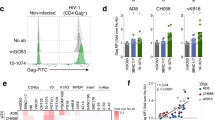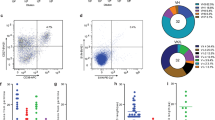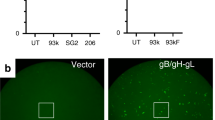Abstract
Receptors for the Fc portion of immunoglobulins or for the third component of complement (C3) are present on a variety of circulating and fixed tissue cells including granulocytes, monocytes, lymphocytes and glomerular epithelial cells1–4. Cells which lack Fc receptors may express them after infection by herpes simplex virus (HSV)-1, HSV-2, cytomegalovirus or varicella zoster virus5–8. We recently reported that infection by HSV-1 induces both Fc and C3 receptors on human endothelial cells9. Glycoprotein E of HSV-1 has been shown to function as an Fc receptor10. We now demonstrate that glycoprotein C (gC) of HSV-1 functions as a C3b receptor. This receptor appears following HSV-1, but not HSV-2, infection. Detection of the C3b receptor is blocked by monoclonal antibodies to glycoprotein C (gC) of HSV-1, but not by monoclonal antibodies to other HSV-1 glycoproteins. In addition, the MP mutant of HSV-1, which lacks gC, fails to express a C3b receptor. These results assign a new function of gC of HSV-1 and demonstrate potentially important differences between HSV-1 and HSV-2 glycoproteins.
This is a preview of subscription content, access via your institution
Access options
Subscribe to this journal
Receive 51 print issues and online access
$199.00 per year
only $3.90 per issue
Buy this article
- Purchase on Springer Link
- Instant access to full article PDF
Prices may be subject to local taxes which are calculated during checkout
Similar content being viewed by others
References
Basten, A., Miller, J. F. A. P., Sprent, J. & Pye, J. J. exp. Med. 135, 610–626 (1972).
Silverstein, S. C., Steinman, R. M. & Cohn, Z. A. A. Rev. Biochem. 46, 669–722 (1977).
Melewicz, F. M. & Spiegelberg, H. L. J. Immun. 125, 1026–1031 (1980).
Dierich, M. P. et al. Molec. Immun. 19, 1255–1265 (1982).
Westmoreland, D. & Watkins, J. F. J. gen. Virol. 24, 167–178 (1974).
Para, M. F., Goldstein, L. & Spear, P. G. J. Virol. 41, 137–144 (1982).
Keller, R., Peitchel, R., Goldman, J. N. & Goldman, M. J. Immun. 116, 772–777 (1976).
Ogata, M. & Shigeta, S. Infect. Immun. 26, 770–774 (1979).
Cines, D. B., Lyss, A. P., Bina, M., Corkey, R., Kefalides, N. A. & Friedman, H. M. J. clin. Invest. 69, 123–128 (1982).
Para, M. F., Baucke, R. B. & Spear, P. G. J. Virol. 41, 129–136 (1982).
Gelfand, J. A., Fauci, A. S., Green, I. & Frank, M. M. J. Immun. 116, 595–599 (1976).
Norrild, B. & Pedersen, B. J. Virol. 43, 395–402 (1982).
Pizer, L. I., Cohen, G. H. & Eisenberg, R. J. J. Virol. 134, 142–153 (1980).
Holland, T. C., Marlin, S. D., Levine, M. & Glorioso, J. J. Virol. 45, 672–682 (1982).
Cohen, G. H., Katze, M., Hydrean-Stern, C. & Eisenberg, R. J. J. Virol. 27, 172–181 (1978).
Vestergaard, B. F. & Norrild, B. J. infect. Dis. 138, 639–643 (1978).
Spear, P. G. J. Virol. 17, 991–1008 (1976).
Montgomery, P. C., Dorrington, K. J. & Rockey, J. H. Biochemistry 8, 1247–1258 (1969).
Griffin, F. M. & Mullinax, P. J. J. exp. Med. 154, 291–305 (1981).
Bianco, C., Griffin, F. M. & Silverstein, S. C. J. exp. Med. 141, 1278–1290 (1975).
Iida, K. & Nussenzweig, V. J. exp. Med. 153, 1138–1150 (1981).
Fearon, D. T. Proc. natn. Acad. Sci. U.S.A. 76, 5867–5871 (1979).
Maciag, T., Hoover, G. A., Stemerman, M. B. & Weinstein, R. J. Cell Biol. 91, 420–426 (1981).
Mayo, D. R. J. Clin. Micro. 15, 773–736 (1982).
Rothman, I. K., Gelfand, J. A., Fauci, A. S. & Frank, M. M. J. Immun. 115, 1312–1315 (1975).
Showalter, S. D., Zweig, M. & Hampar, B. Infect. Immun. 34, 684–692 (1981).
Pereira, L., Klassen, T. & Baringer, J. R. Infect. Immun. 29, 724–732 (1980).
Eisenberg, R. J., Ponce de Leon, M., Pereira, L., Long, D. & Cohen, G. H. J. Virol. 41, 1099–1104 (1982).
Wenske, E. A. & Courtney, R. J. J. Virol. 46, 297–301 (1983).
Author information
Authors and Affiliations
Rights and permissions
About this article
Cite this article
Friedman, H., Cohen, G., Eisenberg, R. et al. Glycoprotein C of herpes simplex virus 1 acts as a receptor for the C3b complement component on infected cells. Nature 309, 633–635 (1984). https://doi.org/10.1038/309633a0
Received:
Accepted:
Issue Date:
DOI: https://doi.org/10.1038/309633a0
This article is cited by
-
The requirement of glycoprotein C (gC) for interindividual spread is a conserved function of gC for avian herpesviruses
Scientific Reports (2021)
-
Interleukin-36β provides protection against HSV-1 infection, but does not modulate initiation of adaptive immune responses
Scientific Reports (2017)
-
Inhibition of HSV-1 Replication by Gene Editing Strategy
Scientific Reports (2016)
-
Distribution characteristics of DNA vaccine encoded with glycoprotein C from Anatid herpesvirus 1 with chitosan and liposome as deliver carrier in ducks
Virology Journal (2013)
-
Immune Regulation and Evasion of Mammalian Host Cell Immunity During Viral Infection
Indian Journal of Virology (2013)
Comments
By submitting a comment you agree to abide by our Terms and Community Guidelines. If you find something abusive or that does not comply with our terms or guidelines please flag it as inappropriate.



